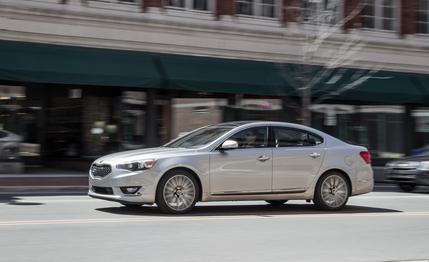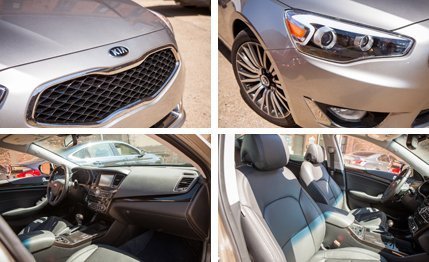
 Instrumented Test
TESTED
Instrumented Test
TESTED
Ponder this 2014 Kia Cadenza’s as-tested price, browse its list of features and upper-crust options, gaze on its handsome body, and one might naturally infer that it’s a luxury car. We’d agree. But after testing the Cadenza, it’s more complicated than that. Consider, if you will, Kia’s startlingly ambitious plan to legitimately compete with luxury brands by 2017, which will be spearheaded by the rear-drive K9/Quoris. The Cadenza plays a role in this mission, although unlike its more overtly luxurious sibling, it’s more of a toe in the water; an attempt to prepare us mentally for more-expensive Kias to come.
As such, everything about the Cadenza feels carefully crafted to impress while taming expectations. Its luxurious tidings and big footprint make it an enticing alternative to smaller—but similarly priced—sedans such as the Acura TL and Lexus ES350. However, its name lacks the alphanumeric nonsense that’s practically a luxury-car prerequisite (XTS, 528i, E550), so it shouldn’t scare away buyers looking at the similarly sized Toyota Avalon, Buick LaCrosse, Chevrolet Impala, Ford Taurus, or the Cadenza’s architectural twin, the Hyundai Azera.
Seriously, Forget the Amanti
The Cadenza technically replaces the milquetoast Amanti, but banish any memory you might have of that car, which Kia mercifully yanked from dealerships three years ago. Starting with styling that mixes elements from the latest Forte sedan, the Optima, and the K9, the Cadenza is much, much better. From some angles it looks derivative—a Volkswagen Passat-ified Suzuki Kizashi comes to mind—but overall, the impression is upscale and even slightly sporty. Even though it’s basically a bigger Optima underneath, the Cadenza looks like its own luxury animal. Like the Toyota Avalon and Camry, the two Kias share a platform, although the Cadenza’s front subframe is unique, as is its body structure aft of the rear seat. (The new subframe accommodates the V-6—the Optima lineup is four cylinder only.) Dimensional differences are relatively minor, with the Cadenza’s wheelbase spanning two more inches, overall length an additional 5.2 inches, width another 0.7 inch, and height another 0.8 inch.


The added size pays off inside, where there’s plenty of room for four passengers—or five over medium distances. The cabin is tasteful and approachable, harmoniously channeling the exterior’s understated feel. Materials and fit and finish in our early production test car were impressive, and the UVO touch-screen infotainment system operated faultlessly and without frustration. As we noted in our 2014 Kia Forte sedan test, UVO’s fonts and graphics match those of the optional digital gauge cluster, as well as the dashboard’s hard buttons. It’s a nice touch that shows Kia sweats some details. The seats and the driving position are comfortable for long hauls, although lateral thigh and back support are lacking.
Who Needs Downsizing and Turbos?
The only powertrain choice is an all-aluminum, 3.3-liter V-6 making 293 horsepower and 255 lb-ft of torque mated to a six-speed automatic transmission. Kia considered adding all-wheel drive for snowy states but ultimately decided front drive was sufficient. The company also explored dropping the Optima’s optional turbocharged four (it makes about the same power) into the Cadenza but decided it didn’t fit the car’s relaxed vibe. The six certainly isn’t any less relaxed when it comes time to hustle. It feels far stronger than its ho-hum specs suggest, and power builds linearly toward the redline near where peak horsepower and torque live. We hit 60 mph 0.2 second quicker (in 6.2 seconds) than in the last turbocharged Optima we tested. That car was 236 pounds lighter and packed more torque. Our observed 25-mpg fuel economy also bettered the Optima turbo’s by 5 mpg and fell right between the EPA’s 19-mpg city and 28-mpg highway estimates.